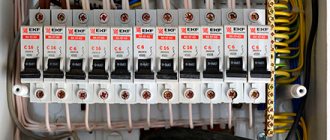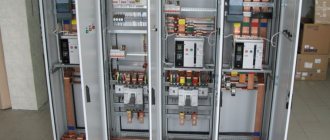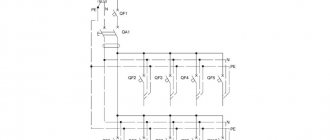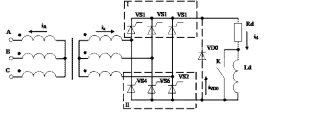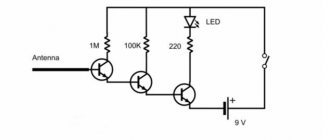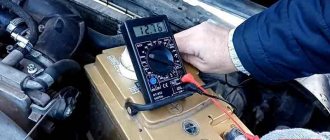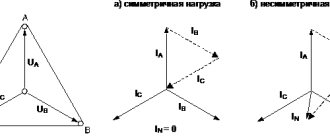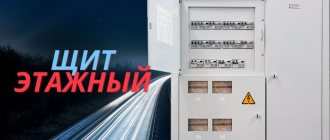Today, very often, private houses are connected to a three-phase electrical network. Also, in some new high-rise buildings, apartments began to have three phases instead of one as before. As a rule, with this connection, local network companies allocate 15 kW of power per house or apartment. This means that the rating of the input circuit breaker should be 25 A. For small offices, cafes, etc. release more power. Therefore, in their shields the ratings of the introductory machines will be completely different.
Connection to a 3-phase electrical network requires the installation of three-phase electrical panels. Below we will look at five different options for simple three-phase circuits for a distribution board.
All schemes are simple and are advisory in nature. They clearly show the essence of the connections of different protective devices in one panel. The development of the design of each shield must be approached individually, since everyone’s conditions are different. The grounding system in the presented versions is TN-S.
Advantages and disadvantages of a three-phase power supply system
To supply electricity to a private home, three-phase power is most often used, since it is superior to single-phase.
Such nutrition can allow:
- use of three-phase motors and other electrical receivers;
- when using a large number of electrical appliances, it is possible to distribute them into three phases, thus reducing the load on each phase;
- allows the use of input cables with a smaller cross-section;
- as a result of a break in one of the phases, the presence of light in the house will still be ensured;
- the risk of fires is significantly reduced.
And yet, along with these positive aspects, there are also a number of negative aspects:
- with a three-phase supply of electricity, the dimensions of the electrical panel will be increased several times. This is due to the size of the meter and the residual current device;
- a voltage of 380 volts can kill a person fatally , while 220V is the maximum permissible safe voltage;
- installation work related to wiring will be much more difficult;
- special attention should be paid to the wiring of the common zero, since if it breaks, an overvoltage will form in the phases, which will inevitably lead to the failure of all devices in this phase;
- the wiring diagram contains many more lines, thus increasing the required number of machines.
Three-phase and single-phase networks. Differences and advantages. Flaws
In the electrical equipment of residential apartment buildings, as well as in the private sector, three-phase and single-phase networks are used. Initially, the electrical network comes from a power plant with three phases, and most often a three-phase power network is connected to residential buildings. Further it has branches into separate phases. This method is used to create the most efficient transmission of electric current from a power plant to its destination, as well as to reduce losses during transportation.
To determine the number of phases in your apartment, just open the distribution board located on the landing, or right in the apartment, and see how many wires enter the apartment. If the network is single-phase, then there will be 2 wires - phase and zero. Another possible third wire is grounding.
If the electrical network is three-phase, then there will be 4 or 5 wires. Three of them are phases, the fourth is zero, and the fifth is grounding. Also, the number of phases is determined by the number of circuit breakers.
Three-phase networks in apartments are rarely used, in cases of connecting old electric stoves with three phases, or powerful loads in the form of a circular saw or heating devices. The number of phases can also be determined by the input voltage. In a 1-phase network the voltage is 220 volts, in a 3-phase network between phase and zero it is also 220 volts, between 2 phases it is 380 volts.
Differences
If we do not take into account the difference in the number of network wires and the connection diagram, then we can determine some other features that three-phase and single-phase networks have.
- In the case of a three-phase power supply, phase imbalance is possible due to uneven distribution of load phases. A powerful heater or stove can be connected to one phase, and a TV and washing machine to the other. Then this negative effect occurs, accompanied by asymmetry of voltages and currents in phases, which leads to malfunctions of household devices. To prevent such factors, it is necessary to pre-distribute the load across phases before laying the electrical network wires.
- A 3-phase network requires more cables, conductors and switches, which means you won't be able to save too much money.
- The power capabilities of a single-phase household network are significantly less than those of a three-phase network. If you plan to use several powerful consumers and household devices, power tools, then it is preferable to supply a three-phase power supply to the house or apartment.
- The main advantage of a 3-phase network is the low voltage drop compared to a 1-phase network, provided the power is the same. This can be explained by the fact that in a 3-phase network, the current in the phase conductor is three times less than in a 1-phase network, and there is no current at all on the conductor.
Advantages of a 1-phase network
The main advantage is the cost-effectiveness of its use. Such networks use three-wire cables, compared to five-wire cables in 3-phase networks. To protect equipment in 1-phase networks, you need to have single-pole circuit breakers, while in 3-phase networks you cannot do without three-pole circuit breakers.
In this regard, the dimensions of the protection devices will also differ significantly. Even on one electric machine there is already a saving of two modules. And in terms of dimensions this is about 36 mm, which will significantly affect when placing the machines in a panel on a DIN rail. And when installing a differential machine, the space savings will be more than 100 mm.
Three-phase and single-phase networks for a private home
Electricity consumption by the population is constantly increasing. In the middle of the last century, there were relatively few household appliances in private homes. Today the picture is completely different in this regard. Household energy consumers in private homes are multiplying by leaps and bounds. Therefore, in your own private property there is no longer a question of which power supply networks to choose for connection. Most often, in private buildings, power networks with three phases are installed, and a single-phase network is abandoned.
But is a three-phase network worth such superior installation? Many people believe that by connecting three phases, it will be possible to use a large number of devices. But this does not always work out. The maximum permissible power is determined in the technical conditions for connection. Typically, this parameter is 15 kW for the entire private household. In the case of a single-phase network, this parameter is approximately the same. Therefore, it is clear that there is no particular benefit in terms of power.
But, it must be remembered that if three-phase and single-phase networks have equal power, then for a 3-phase network you can use a cable of a smaller cross-section, since the power and current are distributed over all phases, therefore, there is less load on the individual phase conductors. The rated current of the circuit breaker for a 3-phase network will also be lower.
The size of the distribution board is of great importance, which for a 3-phase network will be noticeably larger. This depends on the size of the three-phase meter, which is larger than the single-phase one, and the input machine will also take up more space. Therefore, the distribution board for a three-phase network will consist of several tiers, which is a disadvantage of this network.
But three-phase power also has its advantages, which are expressed in the fact that three-phase current receivers can be connected. They can be electric motors, electric boilers and other powerful devices, which is an advantage of a three-phase network. The operating voltage of a 3-phase network is 380 V, which is higher than in a single-phase type, which means that more attention will have to be paid to electrical safety issues. The same applies to fire safety.
Disadvantages of a three-phase network for a private home
As a result, several disadvantages of using a three-phase network for a private home can be identified:
- You need to obtain technical conditions and permission to connect the network from the power supply.
- There is an increased risk of electric shock and also a risk of fire due to the increased voltage.
- Significant overall dimensions of the power input switchboard. For owners of country houses, this disadvantage is not of great importance, since they have enough space.
- It is necessary to install voltage limiters in the form of modules on the input panel. In a three-phase network this is especially true.
Advantages of three-phase power supply for private homes:
- It is possible to distribute the load evenly across phases to avoid phase imbalance.
- Powerful three-phase energy consumers can be connected to the network. This is the most tangible benefit.
- Reducing the nominal values of protection devices at the input, as well as reducing the cross-section of the input cable.
- In many cases, it is possible to obtain permission from the energy sales company to increase the permissible maximum level of power consumption of electricity.
As a result, we can conclude that practically introducing a three-phase power supply network is recommended for private buildings and houses with a living area of more than 100 m2. Three-phase power is especially suitable for those owners who are going to install a circular saw, a heating boiler, or various drive mechanisms with three-phase electric motors.
Other owners of private houses do not need to switch to three-phase power supply, as this can only create additional problems.
Registration of permission
At the first stages, the following will need to be agreed upon with power engineers:
- permissible power;
- number of phases;
- type of input line and energy meter;
- metering tariff (depending on the meter);
- Based on the quality of the insulation of the house electrical network, a connection diagram is agreed upon (if the wiring is old, then permission will not be given);
- How reliable is the grounding of the electrical wiring in the house?
Important! Independent connection to power lines is prohibited by law. The electrical connection must be made by highly qualified specialists.
Next, measurements are made from a private house to 380V networks; if this distance exceeds 300 meters in the city or 500 meters outside the city, then you will have to pay for the installation of an additional support pole.
The next step will be to discuss the required power:
- no more than 16 kW;
- from 16 to 50 kW;
- from 50 to 160 kW.
Typically, up to 50 kW is allowed; if a larger figure is needed, an additional transformer will be required, which is very expensive and difficult.
Further list of required documents:
- a copy of your passport (required to draw up an agreement for connecting electricity);
- application for connection to electrical lines;
- identification code;
- site plan;
- a plan for the placement of the power line pole closest to the site;
- title document for a residential (non-residential) property;
- approved complete residential plan;
- information about the required power and a list of all electrical appliances used in the house (or the estimated number of devices if the house has not yet been put into operation).
The application for electrical wiring to the house should be written in two copies, in order to keep one (with the visa of the specialist accepting the document).
How to connect to electrical networks - pressure levers
The law regulates the rules for supplying electrical energy to the boundaries of consumers’ land, but in some cases the applicant may encounter some problems:
- failure to issue a contract by the electricity network;
- violation of technological connection deadlines;
- refusal to accept the application.
Combined boilers for wood and electricity are optimal for a country house, read on.
Any applicant must know their rights and obligations of energy supply organizations , and also be guided by current regulations:
- the electrical network must be stretched no further than 25 m from the boundaries of the site;
- commercial value applies to cases outside the established norms;
- working rules are regulated by Decree No. 861.
Any activity of an ESO that goes beyond the law, including violations of work rules, is suppressed by the antimonopoly services and threatens the organization with a large fine.
Several rules when connecting 380 volts in a private home
Outdated power lines are gradually being modernized and transferred to the new TN-CS model. With this method, the fourth PEN wire is laid from the supply substation not with one wire, but with two disconnected wires: PE and N.
Input of three-phase voltage into the building
To connect 380 volts to a private house, you must follow some rules:
- voltage is transmitted from the transformer substation via power lines (four wires), which include three phase conductors (L1, L2, L3) and one common neutral wire PEN;
- Most often such a line is overhead and less often cable.
A three-phase connection is based on the connection of all conductors to the input apparatus of the object. Next, the current enters the metering device and passes into the distribution panel, for the purpose of subsequent distribution to electrical receivers.
In the middle of the input device, the working zero N and the protective zero PE are separated. Then they are connected to the main ground bus (GZSh). Then it is connected to the repeated grounding circuit of the room.
The last section of the line from the support to the entrance to the house is carried out by air or underground. It is also called a branch. It is listed on the balance sheet of the power supply organization, so the connection of the house is made with the permission of the owner of the power line.
If the cable line runs underground, then the branch is mounted in a metal cabinet, which will be located near the route, and for overhead power lines - directly on the support. In both cases, the owner is obliged to ensure their safe operation and prevent unauthorized people from invading the electrical panel.
Important! Carrying out work on the end of the PEN conductor located on the support by residents of the house is prohibited by the rules.
Outgoing lines
With three-phase power supply, an input distribution board (IDB) is installed on the facade of the house. It is in it that the PEN conductor is separated and the input circuit breaker is installed, as well as circuit breakers for the group circuits of the house.
All three phases L1, L2, L3 are connected to a three-pole input circuit breaker (3). An electricity meter is also installed there in order to keep track of the resource consumed. Three conductors from the input machine and conductor N from the main generator are connected to the input terminals of the metering meter. The electricity meter output is connected to a common circuit breaker (four-pole) for protecting the entire house. If it goes off, the entire house will be cut off from power.
Electric installation work
We will not dwell in more detail on the preparation of documentation for connecting the power supply; this is a separate topic. Our task is to determine the materials and devices for external installation work, which, although they are an intermediate stage in the connection, are the most important, since they are related to human safety.
Single-phase or three-phase input?
For both three-phase and single-phase networks, the permitted power is indicated in the technical specifications. This can be 15 kW for both options, that is, the benefit of a three-phase network is not in power, but in the possibility of using an input cable of a smaller cross-section and reducing the load, since the current is distributed over 3 phases. Therefore, in a three-phase network, the rating of the input circuit breaker will be lower.
But the input distribution board will be increased in size, since the meter itself is larger than a single-phase one, and the circuit breakers occupy 3-4 modules. Three-phase RCDs also have larger dimensions. This is a disadvantage of three-phase input into the house, but it is not very significant compared to such advantages as the ability to connect asynchronous electric drives, electric boilers, heaters, and electric stoves in the house.
To avoid phase imbalance from powerful electrical receivers, the electrician-installer must distribute the load as evenly as possible. The operating voltage of a three-phase network is 380V, therefore, in order to eliminate the risk of fire and electric shock, it would be a good idea to install a three-pole additional circuit breaker right before entering the house. This prevents short circuits at the input.
External connection and electrical panel
When connecting a private house to the power supply, an air input is most often used (which is also indicated in the technical specifications) with the installation of an electricity metering cabinet (SHUE) to eliminate cases of electricity theft and problems with the commercial registration of electricity supply.
According to the standards, the input cable must have a cross-section of at least 16 mm2 if the core is aluminum, and 10 mm2 if the core is copper, at a distance from the support pole of 25 m. For a distance of less than 25 m, the cross-section of the aluminum wire is 10 mm2, copper - 4 mm2 .
If you have decided on the method of connection from the pole to the house (aerial or underground), as well as the type and cross-section of the cable, then it remains to figure out exactly how the wire is connected to the house, from where further wiring to the devices is made.
The wire cross-section is selected according to the PUE based on the long-term permissible current. For aerial input, the most common cable is VVG or VVGng (modern version), as well as cable AVVG and SIP (self-supporting wire). By the way, for underground input, VBBbShv or AVBbShv cable is most often used. As you already understand, the presence or absence of the letter “A” means an aluminum core.
The value of the cable cross-section and the long-term permissible current for it are taken from the PUE. The optimal cross-sections for the input cable are 10, 16, 25 mm2, with a maximum permissible current, respectively: 50, 70, 85A (for underground input), and 80, 100, 140A for air input. For example, to a copper wire with a cross-section of 10 mm2, you can connect a power of 15 kW for a voltage of 230 V and from 30 kW for a voltage of 380 V.
If your main grounding bus is located on a pole and not in a cabinet, then the cable from the pole should be five-core (for example, VVG5 x 4.0) - three phases, a working zero (N) and a protective zero (PE).
High-quality cable products are produced domestically, Sevkabel, Concord, Nexans.
The entry point into the house should be located at a height of 2.75 m. It happens that the height of the house is not enough, then a special pipe stand, straight or curved (gander), is installed in the hole in the roof or wall. If the house is high, then the distribution cabinet with an RCD is mounted on the wall, where the cable is led from the pole.
According to the rules, the distance from the pole to the house should be less than 25 m, so as not to install additional support. The electricity metering and distribution cabinet provides all the devices necessary for protection, metering and further distribution of electricity in the house:
- input device - automatic or switch type RPS;
- electric meter (electronic or induction);
- residual current device (RCD);
- a number of circuit breakers protecting the network from short-circuit currents and overloads. Here you can also use DIFs - (differential circuit breakers).
An input circuit breaker or switch is included in the circuit in front of the meter for possible disconnection of all phases of the supply voltage. This is done so that the meter can be replaced safely.
For commercial electricity metering, a meter is installed in the cabinet. If necessary, you choose an electricity meter for a single-phase network (220/230V) or three-phase (220/380V), single-tariff or multi-tariff. With an supplied power of 15 kW, it is enough for the maximum load current of the meter to be in the range of 50-60A. This corresponds to the rating of the input circuit breaker no more than 40A. Models of modern meters: "Mercury" 200.02 220V 5(50)A - designed for single-phase circuits, "Mercury" 230 ART-03 5(7.5)A - for three-phase.
An RCD protects a person from electric shock, and a house from a fire, therefore, it is imperative to install it in the electrical panel. Instead of an RCD, you can use a differential circuit breaker.
| 1 | Introductory machine |
| 2 | Counter |
| 3 | Fire protection RCD |
| 4 | Common zero bus |
| 5 | Lighting machines |
| 6 | RCD for consumers 2, 3, 4 |
| 7 | Vending machines for consumers 2, 3, 4 |
| 8 | Additional zero bus |
| 9 | Differential automatic |
| 10 | RCD for consumers 5, 6, 7 |
| 11 | Vending machines for consumers 5, 6, 7 |
| 12 | Additional zero bus |
| 13 | Ground bus |
In our electrical networks, there are frequent surges and surges in voltage, from which a voltage stabilizer . It smooths out fluctuations by supplying 220V to the output. When the voltage drops below 160V, or when it increases above 280V, the stabilizer is usually disconnected from the external network and de-energizes consumer devices, protecting them from damage. Audio and video equipment, as well as light bulbs, are especially sensitive to surges, as they flicker and their service life is reduced.
The dimensions of the stabilizer depend on the power of the connected load, therefore, they can be bulky and require a lot of space for placement, while there must be space on all sides of the stabilizer so that it can be cooled by air.
Installation cost
Installing electrical wiring is an important issue. A correctly drawn up house wiring plan is a guarantee of safety. If a person has never encountered such a problem in his practice, then it is better to seek help from trusted specialists.
To do this, you should familiarize yourself with the approximate prices for this type of service:
Initially, you should be prepared for the fact that installing electrical wiring in a house will cost much more than in an apartment.
Electrician's recommendations
You should adhere to the basic rules when working:
- horizontal transitions from the junction box to the sockets or switch are laid at a height of 2.5 m;
- the insertion of veins is carried out only vertically or horizontally;
- connection points should only be located in mounting boxes;
- for underground cable laying, you need to use only a single piece with a strong armor tape;
- The biggest mistake is installing the switch in the zero gap;
- It is forbidden to install electrical wires near a wooden surface, but if this is unavoidable, then an insulating hose or gasket made of asbestos and steel with a thickness of 0.2 - 0.5 mm is used.
Branch design features
Most often, a three-phase connection to a house on a power line is carried out by an overhead line, on which a short circuit or break may occur. To prevent them, you should pay attention to:
- the overall mechanical strength of the created structure
- quality of outer layer insulation
- current-carrying material
Modern self-supporting aluminum cables are lightweight and have good conductive properties. They are well suited for installing an air branch. With three-phase power supply to consumers, a SIP core cross-section of 16 mm2 will be sufficient for long-term production of 42 kW, and 25 mm2 - 53 kW.
When a branch is made using an underground cable, pay attention to:
- the configuration of the route being laid, its inaccessibility to damage by unauthorized people and machinery when working in the ground
- protection of ends coming out of the ground with metal pipes to a height no less than average human height
The best option is to completely place the cable in the pipe up to the entry into the control unit and the distribution cabinet.
For underground installation, use only a single piece of cable with strong armor tape or protect it with pipes or metal boxes. In this case, copper conductors are preferable to aluminum ones.
The technical aspects of three-phase connection of a private house in most cases require greater costs and effort than with a single-phase circuit.
We assemble an electrical panel for a private house at 380 V 15 kW
Assembling an electrical panel for a private home with a voltage of 380 V and a power of up to 15 kW requires an appropriate approach and the presence of the following tools:
- pliers;
- flat and figured screwdrivers;
- crimping pliers;
- assembly knife with a set of replaceable blades.
All work begins with planning, and if the home owner prefers to contact an electrical company, then a project and preliminary diagram are drawn up before installation begins. You should also prepare the components of the shield and consumables (crimping lugs, heat shrink, DIN rail, dowels).
Load distribution algorithm across three phases
As already mentioned, it is necessary to collect the entire single-phase load and distribute it evenly between the phases. Moreover, the trick is to select everything so that powerful devices connected to one phase do not cause an overload shutdown. This is possible if the total power of the operating devices is no more than the nominal value, or if these devices do not operate simultaneously.
A 380 V apartment panel may not be very large
General principles of load grouping for automatic machines
The most reliable and easy-to-maintain scheme is when for each group of consumers or powerful device there is a separate machine, and together with it an RCD. But such a scheme, firstly, is expensive, and secondly, it simply requires a huge cabinet, which is also not cheap. Therefore, they try to connect several lines to one machine, but they must be combined following a certain logic. Otherwise, it will be very difficult to figure out what’s what when the machine is triggered. You should adhere to the following rules:
- Connect sockets and lighting in one room through different machines. In this case, if there are problems in one of the groups, the room will not be completely de-energized.
- “Wet” rooms - bath, kitchen, bathhouse - should not be grouped with “dry” ones. Firstly, in rooms with increased danger, machines should have different parameters, and secondly, it is in wet rooms that problems usually arise.
- Street lighting and street sockets generally should be separate - on separate machines. Outbuildings can be connected to them.
- The power supply for the gate drive and security lighting are also separate machines.
Make a plan for a three-phase electrical panel - distribute the load between three phases
- Separate power lines and separate circuit breakers and RCDs are installed on both powerful household appliances (electric stoves and electric ovens) and those that use water. As a last resort, you can combine, say, a washing machine and a dishwasher. You can also combine instantaneous and storage water heaters into one group, but on the condition that they will not turn on at the same time, since they are highly likely to trigger an overload shutdown. Moreover, they can be connected to one machine only if they are installed in the same room, otherwise you will not understand anything if damaged.
To make it easier to form groups, make a list of lines and the load on them. The room, line name and power of the connected load must be indicated. Looking at this table, following the rules described above, you assemble groups. At the same time, you must also ensure that the load is distributed more or less evenly.
Checking groups
After you have sketched out the groups on paper, check them. Sit down and think about what will happen if each of the machines works, how catastrophic the consequences will be for each room.
You can assemble a 380 V switchboard for a private home with your own hands, but you must first figure out how to distribute the load
For example, if in a two-story cottage you connect all the sockets of the first floor and the lighting of the second to one machine, and the lighting of the first, the sockets of the second to another, and the equipment to the third, then when any of the machines is triggered the situation will be terrible.
This is how we lose situations with each machine being turned off. It is advisable that there be either working sockets in the room or that they be in the adjacent one. Then, if necessary, it will be possible to connect equipment and lighting.
What elements does an electrical panel consist of?
It is necessary to purchase the components of the electrical panel immediately, so as not to subsequently waste time and not travel to the electrical store several times a day. The power of the shield is determined, it is 15 kW, which means that the maximum power consumption will not exceed 15 kW/h.
Electrical panel of a private house, list of elements:
- Electric energy meter. The meter is the first element that must be installed in the panel. The best solution would be to purchase an electronic device designed to connect three phases. Such measuring instruments have high accuracy and a long service life. All information is displayed on a digital screen. Electronic meters can be programmed to operate in several tariffs.
- Electrical shield. Now in stores there are a large number of electrical panels of various sizes and designed for a certain number of elements. The price of the product varies depending on the presence of a DIN rail, a built-in lock, as well as an inspection window (especially for taking readings from the meter). You should pay attention to protection from dust and moisture, its level should be at least IP 54. Dimensions - 445 × 400 × 150, and a wall thickness of 1 mm.
- Input circuit breaker. You should purchase a three-pole machine, because the voltage supplied to the house will be 380 V, which means the presence of three phases.
- Residual current device (RCD). It is required to be installed, since it is a protective element when a dangerous potential appears on the body of an electrical device.
- Circuit breakers. The amperage should be selected based on the consumer load, which will be discussed below.
- Voltage relay. Protects household electrical appliances from power surges. Many users install a relay, but it is not a required element. Also now widely used is the surge protection device (SPD). For example, when lightning strikes an overhead power line, the voltage in the house will reach high limits, which will be destructive for all equipment. The SPD will turn off the network in time, but, like the voltage relay, it is not installed often.
- Measuring instruments. They are also an optional element of the electrical panel. Measuring instruments include ammeters and voltmeters, often combined into one product.
Electricity input distribution device
It differs from a simple input device in that its design includes elements that distribute electricity among consumer groups inside the building. It is mounted at the electrical cable input in an extension or some separate room.
The ASU is installed inside a metal cabinet, where all three phases, a PEN conductor and a re-grounding circuit bus are connected in the building connection diagram using the TN-CS system.
Inside the input switchgear cabinet, the phase conductors are connected to the terminals of the input circuit breaker or power fuses, and the PEN conductor is connected to its busbar. Through it, it is split into PE and N with the formation of the main grounding bus and its connection to the repeated grounding loop.
Voltage increase limiters operate on a pulse principle, protect the circuit diagram of phases and working zero from the effects of possible penetration of extraneous external discharges, divert them through the PE conductor and the main protective bus with a ground loop to the ground potential.
When high-voltage pulse discharges of high power occur in the supply line and pass through a serial chain of a circuit breaker and an SPD, it is quite possible that the power contacts of the machine will fail due to burning and even welding.
Therefore, the protection of this chain with powerful fuses, carried out by simply burning out the fuse link, remains relevant and is widely used in practice.
A three-phase electric meter takes into account the power consumed. After this, the connected loads are distributed among consumption groups through properly selected circuit breakers and residual current devices. There may also be an additional RCD at the input, which performs fire-fighting functions for all electrical wiring of the building.
After each group of RCDs, consumers can be further divided by degree of protection with individual circuit breakers or dispensed with, as shown in different sections in the diagram.
Cables going to groups of end consumers are connected to the output terminals of the shield and protection.
Which circuit breakers to choose for the electrical panel
The main question that affects many users is: how to decide on slot machines? The rated current of the circuit breaker is calculated based on such parameters as the consumer’s load or its power.
For example. The rated power of simultaneously switched on electrical appliances and the lighting network will be 15 kW. There is a formula: P=U×I, where P is power, U is voltage, I is current. If P = 15000 W, then the current strength will be (rounded) 68 A. This means the sum of the rated values of the machines should not exceed 68 A. But it should be remembered that a three-phase network is connected to the switchboard, so the rated amperes must be divided by 3, which will give approximately 23 A. This means that the input circuit breaker should be set to 25 A.
Auto switching circuit
You can eliminate manual selection of a power source by using an auto-switching circuit for the load connected to it. Its structure at least includes a control unit and 2 contactors (starters) with cross connection. The main of these devices, produced on the basis of a software-controlled device, semiconductor triodes or analog integrated circuits, carries out the following activities:
- recognizes situations with the disappearance of electricity in the main supply line;
- after this, disconnects the consumer from it;
- switches it to a 3-phase generator.
During the operation of the unit, which recognizes the cessation of the centralized energy supply, a long-duration current pulse is generated and supplied to the actuator (starter coil). This leads to the switch automatically switching to operating mode from the generator. If centralized power is restored, another control pulse switches the system to its original state.
Sequence of correct installation of an electrical panel
To ensure that the electrical panel in your home is installed correctly, you should use only high-quality electrical products, as well as consumables. Only after installation is completed, operating voltage is supplied to the panel.
The correct assembly of a three-phase electrical panel has the following sequence:
- Installation of an introductory machine. The device rating must cover the maximum power consumption. Since 3 phases will be brought into the house, the voltage between them will be 380 V, it is necessary to install a three-pole circuit breaker. To save money, it is not recommended to install 3 single-pole circuit breakers and connect them with a special strip. The input machine is installed in the upper left corner of the shield and is marked accordingly.
- After the introductory machine, it is necessary to install an RCD. The rating of the device must correspond to the rating of the input switch. You should also pay attention to the cut-off current - the lower this indicator, the faster the RCD will turn off the network. There are differential circuit breakers that include protective functions against short circuits and shutdown the network when a leakage current occurs (RCD and standard switch). It is easier to use such a product, but its cost is quite high.
- To the right of the RCD, at a short distance, a zero bus is mounted. Modern busbars provide a plastic dielectric between the copper strip and the shield body. This is done so that if the zero burns out and a phase gets on it, the electrical panel does not end up under life-threatening voltage.
- Measuring instruments and voltage relays can also be placed on the strip with the input circuit breaker, RCD and zero bus. If you install a voltmeter and an ammeter in a three-phase network, then you must select products that display both linear and phase loads. And also capable of showing data on each phase separately.
- The lower DIN rail contains automatic switches for power and lighting lines. In order not to get confused and not constantly look at the rating of the machines, lighting line products should be located at a short distance from the power switches.
After assembling the shield, you can mount it to the wall and connect the wires from consumers to the machines. An example of an electrical panel diagram, the number of machines can vary depending on the wishes of the owner.
If the electricity metering panel with a voltage of 380 V is not located on the street, then it is first installed in front of the input machine. But installing a device to monitor electricity consumption in the house is inconvenient, so inspectors (to save time and the absence of owners) must take readings on the street.
Selection of cables and components
Today's standard wiring diagram for a private house includes two circuit breakers. One - input - is installed before the meter, usually on the street. It and the meter are sealed upon commissioning. The second RCD machine is placed in the house in front of the panel. The operation (shutdown) current of these devices is selected so that the circuit breaker installed in the house is turned off first (its current value is slightly less). Then, in the event of an emergency, you will not need to crawl under the roof.
Typical wiring diagram for a private house: there can be many different groups
If the estimated load is less than 15 kW, the circuit is standard - RCD + automatic circuit breaker, meter and then division into groups. For higher power consumption, it will be necessary to install a transformer; its parameters and the parameters of all equipment will be indicated in the project.
Recently, when connecting a private house to the power grid, they are required to install a meter and a machine on the street. This requirement is not supported by law; it is simply easier for the electricity service to control consumption. If you want, you can fight, if not, choose a meter and machine in a case with increased dust and moisture protection - a protection class of at least IP-55. For installation inside a building, the protection must be less - IP-44, and accordingly the price will be lower.
Cable selection
For electrical wiring in a private home, it is better to use cables rather than wires. Their insulation is at least twice as good, therefore the laying requirements are not so stringent, and they are safer to use. All internal wiring in a private home must be made with protective grounding. Previously, there were no such requirements, but now many electrical appliances have three-pin plugs and require grounding for safe operation. Therefore, the cable must be three-core.
In electrical cables, the cores are made of copper or aluminum. Although aluminum is cheaper, it is used less often: it is rigid, more likely to break, and more difficult to work with. If you install electrical wiring in a private home yourself and lack experience, this can become a problem. In addition, it cannot be used inside wooden houses at all.
Determination of core cross-section
Once you have decided on the material, you can select the diameter of the cable cores. This is done depending on the planned load on the line according to the table.
Calculation of electrical wiring - the selection of the cross-section of the cable cores is carried out according to this table
The cross-section of the core is selected according to the current or power of all consumers connected to one circuit breaker. This is where your home electrification plan, where you have outlined consumer groups, will come in handy once again. You calculate the sum of the currents or powers of all devices and select the desired cross-section of the cores according to the table.
How to use the table? If you decide to lay copper wires, the input voltage is 220 V, then the left part, the corresponding column, is suitable for internal wiring. The found power of all consumers connected to the group will be compared (it is easier to find and calculate). In the part where we are talking about copper wires laid in trays, voids, channels, in the “220 V” column, find the nearest higher value. Follow this line to the right to the column “Section, sq. mm". The number indicated here will be the required core size. From conductors of this diameter it will be necessary to make electrical wiring from the machine to sockets or switches.
In order not to get confused when counting and laying, designate wires of the same diameter on the plan with a certain color (write it down so as not to forget what color you designated what). After the diameter has been determined for all consumer groups, the length of the required cables for each size is calculated, and a margin of 20-25% is added to the found figures. You have calculated the wiring for your home.
Shell type selection
There are certain requirements for the type of sheath only when laying electrical wiring in wooden houses: it is recommended to use triple (NYM) or double (VVG) cable insulation. In houses of less flammable materials, any insulation can be used. The main thing is that it is intact, without cracks, sagging or other damage. If you want to play it safe, you can use conductors with enhanced protection. This makes sense in rooms with high humidity (kitchen, bathroom, swimming pool, bathhouse, etc.).
Selection of sockets and switches
For some powerful devices, sockets are selected according to the maximum (starting) current. For other low-power consumers they are standard. You need to know that they exist:
- External - when the body sticks out from the wall. They are easier to install: a backing is attached to the wall, and a socket is attached to it on top. But few people use such models now, even at their dachas. The reason is aesthetic: not the most attractive sight.
- Internal. A recess is made in the wall for the electrical part, and an installation box is installed and walled up in it. The electrical part of the socket or switch is inserted inside this box.
It is indoor electrical sockets and switches that are most often used today. They are decorated in different styles and painted in different colors. They are selected mainly to match the finish, and if this is not possible, they are installed in white.
Some useful tips for assembling a shield
When assembling an electrical panel, it is necessary to use only high-quality and reliable electrical products. You should not pay attention to cheaper Chinese analogues; personal safety is much more important.
To connect wires to machines, it is best to use special lugs for crimping. Of course, then you will have to purchase pliers with which crimping is performed, but their cost is not too high.
The use of insulating tape is no longer relevant; many electricians use exclusively heat-shrinkable tubing. This consumable is convenient and reliable, and it is not necessary to purchase a hair dryer; you can use an ordinary lighter.
For ease of use, all elements of the electrical cabinet must be marked. Only then will it be possible to quickly and easily turn off the voltage in a certain room. You can make notes on the body of the device or make small signs and attach them to the product with tape.
Electrical supply diagram for a private house 380V 15 kW
One of the most important stages in the construction or renovation of a country house is its electrification. In modern housing, a large number of household appliances and all kinds of equipment are installed, and all these devices consume electricity. Therefore, we have to solve such an important issue as connecting the facility to the power grid. To do this, first of all, you will need a 380V, 15 kW power supply circuit for a private house, which can be of two types - single-phase and three-phase. Both options are in demand, but recently preference has been given to a three-phase circuit, which significantly reduces the load on the network due to its even distribution in the form of three parallel lines.
Features of the arrangement of the distribution panel
A single-line diagram of a 15 kW 380V metering panel (as a special case) is the most common option for constructing this part of the power supply system. When arranging it, the following configuration options are considered, taking into account the differences between single-phase and three-phase power supplies:
- Using standard single-pole circuit breakers and RCDs (one for each phase) as protective equipment.
- The use of only 4-pole differential devices in the circuit.
- Installation of two-pole circuit breakers in the panel, supplemented with a cross-module and an RCD.
- Installation of single-pole linear circuit breakers together with a 4-pole RCD and cross module.
Each of these options, if there is space in the panel, is suitable for arranging and connecting a full-fledged three-phase power supply system. The choice of a specific set of switching devices depends on the preferences and financial capabilities of the owner of a country home.
Three-phase connection
First of all, you need to prepare all the necessary documentation. It includes technical operating conditions that are issued by the organization that supplies electricity. Based on the technical conditions, design documentation for the electrical supply of the facility is drawn up.
You will need the following documents:
- Agreement with the energy supply organization.
- Inspection report of existing electrical equipment.
- Conclusion of a laboratory study of a circuit designed for a specific object.
- The act of delimiting electrical networks by balance sheet.
The project being drawn up takes into account the specifics of further electricity consumption. All consumers are divided into groups, which include sockets and lighting systems. Each group can be switched off separately if repair work is required. At this time, the other group continues to be used without causing unnecessary inconvenience to the owners.
For all groups, calculations of the maximum power consumption of electricity are performed. In accordance with this, the most optimal cross-section of conductors is selected. As a rule, lighting lines are laid with a cable whose cross-section is 1.5 mm2, and for sockets no less than 2.5 mm2 is required. Each group is connected to automatic protective devices that prevent fires in the wiring in the event of a short circuit.
Thus, if you have a connection project, you can calculate the need for materials, instruments and equipment, as well as determine the dimensions of the electrical panel in advance. The attached diagrams mark all the places where switches, sockets, stabilizing devices and other stationary equipment are located.
Direct connection can be made underground or overhead. As a rule, in private homes the second option is used, which has a number of significant advantages. In this case, you can use any connection diagrams with minimal time spent on completing the work. During further operation, overhead lines are much easier to repair. Of great importance is the cost of connection, which is much lower than when using an underground cable line.
When making an air connection, you should take into account the distance from the house to the pole, which should not exceed 15 m. In the case where the distance is greater than this, the installation of an additional pole is required. Due to this, severe sagging or breakage of the wire under the negative influence of external factors is eliminated. You should also pay attention to ensure that the wires do not interfere with pedestrians and vehicles. The mounting height of a three-phase line is at least 2.7 m or more. The wires themselves are installed on special insulators, and only then they are brought from the pole to the power panel.
It is recommended to install the power shield on the facade of the building, then the wires go from it to all rooms. If there are electrified extensions, the supply line is also supplied to them from the panel. To connect and account for consumed electricity, a three-phase meter is required. Mostly direct switching devices are used, the operating principle of which resembles a single-phase meter. In this case, you just need to correctly follow the device connection diagram located on its back cover or in the technical data sheet.
In some cases, a semi-indirect connection scheme for a three-phase meter can be used in a private house. The connection diagram is supplemented with a voltage transformer. To pay for consumed electricity, the device readings must be multiplied by the transformation ratio indicated on the transformer.
Selecting the location for splitting the PEN conductor
It can be done:
- on the nearest support
- or on an input panel located on the wall or inside the house
In the first case, the responsibility for safe operation lies with the electricity supply organization, and in the second, with the owner of the building. Access for residents of the house to work at the end of the PEN conductor located on the support is prohibited by the rules.
It should be taken into account that the wires on the overhead line can break for various reasons and malfunctions may occur on them. During an accident on the supply power line with a break in the PEN conductor, its current will flow through the wire connected to the additional ground loop. Its material and cross-section must reliably withstand such increased power. Therefore, they are chosen no thinner than the main core of the power line.
Three-phase connection at home, breakage of the PEN conductor at the transformer substation
When splitting is performed directly on the support, a line called re-grounding is laid to it and the circuit. It is convenient to make it from a metal strip buried 0.3÷1 m into the ground.
Since it creates a path for lightning to flow into the ground during a thunderstorm, it must be diverted away from paths and places where people may be accommodated. It is rational to lay it under the fence of the building and in similar hard-to-reach places, and make all connections by welding.
When splitting is carried out in the water shield of a building, emergency currents will flow through the branch line with connected wires, which only conductors with the cross-section of the phase conductors of the power line can withstand.
Single-line power supply diagram for a private house
When developing the power supply for private houses, a single-line diagram is most often used as the most optimal option. It allows for simple design and installation, even in-house. The single-line diagram has proven itself to be effective and easy to use. At its core, it is a highly simplified circuit diagram, where all types of connections and network laying are made with one line of the same thickness. This is where the name single-line diagram came from.
There are two options for single-line diagrams - calculation and executive. The first option is used in the process of building a house. This diagram determines the procedure for installing cable lines at a specific facility and the selection of protective equipment. Calculations of all power loads on this network are preliminarily performed. The calculated single-line diagram indicates all available powers and their values. The location of the ASU must be noted and electrical panels must be marked.
The executive diagram is carried out for existing electrical installations when the house has already been built. By this time, the results of a building survey have already been received from the design organization to prepare the most suitable location of all elements and power supply devices.
{SOURCE}
Single-phase and three-phase connection
There are many technical differences between single- and three-phase connections. For example, a three-phase connection is made using four or five wires. Of these, three are phase, through which current is supplied, and the remaining two are the neutral wire and grounding. In some cases, one common wire is used for neutral and ground.
When connecting using a single-phase circuit, two or three wires are used. This corresponds to phase zero and grounding. Using two wires means that neutral and ground are on a single conductor. Knowing the number of phases in advance, you can make calculations of the permissible power and determine the amount of electrical equipment that can be simultaneously connected to the network on each line.
Read also: How to pluck a goose with an iron
In the case of a single-phase connection, all the supplied voltage is concentrated on one line, which often leads to overloads. The thickness of the wires on the internal lines of a home network is much higher than those used in a three-phase circuit. This is due to the higher load that falls on only one line. Taking into account all of the above factors, when installing power supply for a private home, preference is most often given to three phases.
